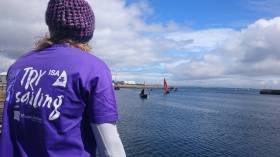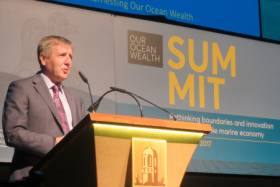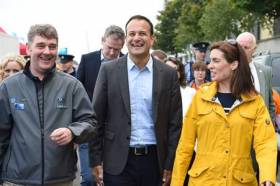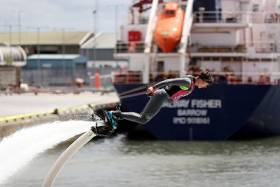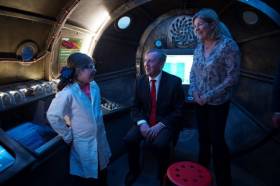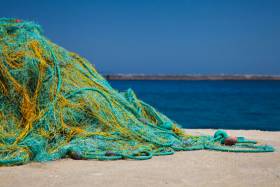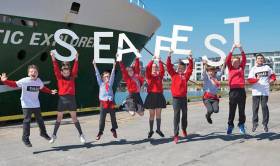Displaying items by tag: SeaFest 2017
Irish Sailing Shares The Love At SeaFest 2017
#TrySailing - Galway skippers, scouts, clubs and centres volunteered their time during SeaFest 2017 to give 555 children and adults a Try Sailing experience on Galway Bay.
Over 100 volunteers represented the likes of Galway Bay Tours, Galway Bay Sailing Club, Galway City Sailing Club, Galway Sea Scouts, Clifden Boat Club, Spiddal Sailing Club and na Badoiri na Claddagh.
Together they combined boats and manpower to give some of the 100,000-plus SeaFest visitors a chance to sail or motorboat, experience the power and history of the Galway Hooker, and in general share their love of sailing and the sea.
Try Sailing at SeaFest, in association with the Marine Institute, was part of Irish Sailing’s nationwide initiative to get more people involved in the sport without big money, a club membership or even needing to own a boat.
Try Sailing opportunities like crewing, training, open days, starter sessions and more are held throughout the year across the country. Visit www.trysailing.ie to find what’s closest to you.
Galway Nets Over 101,000 Visitors For SeaFest 2017
#SeaFest - Ireland’s national maritime festival, SeaFest 2017, attracted 101,113 visitors to Galway Harbour during the three day event this past weekend – generating €6.3 million for the city.
According to organisers, the figures show a phenomenal 68% growth in attendance in just one year.
Last year SeaFest saw 60,000 people attend the festival in Galway, while its inaugural year in 2015 attracted 10,000 visitors.
Marine Institute chair Dr John Killeen said that both SeaFest and the accompanying Our Ocean Wealth Summit “have both exceeded our expectations in terms of attendance and also for creating public awareness of the immense marine resources which are abundant around the island of Ireland.
“We are now, as a country, beginning to become more aware of the potential wealth that can be generated by our seas. SeaFest offers a platform to engage the public in the importance of our seas and the contribution to our local and national economy.”
Figures released by SEMRU at Our Ocean Wealth Summit, held as part of SeaFest on Friday 30 June, show that Ireland’s ‘blue economy’ is performing better than the general economy, as previously reported on Afloat.ie.
On a local level, SeaFest 2017 generated €6.3 million in direct income for the city’s tourism industry.
Accommodation, restaurants and other businesses across Galway benefited from the huge influx of people that descended on Galway Harbour over the weekend.
“SeaFest was a spectacular success and once again shows Galway’s unrivalled capacity to hold national and international maritime events,” said Galway City Council’s Mayor Pearce Flannery.
“Galway has enormous potential to become a leader in the marine world, given it is home to the Marine Institute and the Ryan Institute at NUI Galway, and its natural harbour which is a magnificent resource for the city.”
Marine Institute chief executive Dr Peter Herffernan said the festival “would not have been possible without the huge support from a wide range of local, regional and national agencies who came together to plan and stage this large-scale event. Our festival volunteers also played an important role in making SeaFest 2017 one to remember.”
Galway Harbour was transformed into a giant interactive ‘sea world’ for the three-day festival and the waterfront was awash with non-stop activities and entertainment for those of all ages. All the events taking place during SeaFest were all free for festival-goers.
Crowds got to enjoy thrilling performances and breath-taking aerial acrobatics in the heart of the harbour from world women’s flyboard champion Kristen Smoyer and New Zealand’s Beau Weston.
Free sailing and kayaking was on offer and the Irish Sailing Association — now rebranded as Irish Sailing — also offered disabled access for budding sailors over the weekend.
Open tours were available on a number of vessels in the ship-filled harbour including the tall ship Phoenix, the Naval Service vessel LÉ Ciara, the Commissioners of Irish Lights’ Granuaile and the Marine Institute’s research vessel Celtic Explorer.
The huge display from the Defence Forces was popular with the young and young at heart. Elsewhere, BIM and Bord Bia’s Seafood Experience featured live cookery and fishmongery demonstrations, as well as interactive exhibits and displays of live fish and shellfish species.
Marine-inspired entrepreneurs based in the West of Ireland shared their stories in the LookWest.ie Marquee, while children got creative with the art and craft workshops in the dedicated Kids Zone, and enjoyed storytelling sessions, face painting and marine-art installations.
Roving seafaring entertainment from sword-fighting pirates and giant sea-themed puppets also added to the exciting carnival atmosphere.
SeaFest 2017 also extended to the Latin Quarter, Salthill and Rusheen Bay, while the Wild Atlantic – Sea Science gallery at Galway City Museum and an exhibition on polar explorer Roald Amundsen at NUI Galway were also part of the festival line-up.
SeaFest returns to Galway next summer from 29 June to 1 July 2018.
National Marine Research & Innovation Strategy Launched
#MarineScience - The new National Marine Research & Innovation Strategy 2017-2021 aims to fulfil the need for a strategic marine research agenda to promote cross-agency collaboration, says Ireland’s Marine Minister.
Michael Creed welcomed the new strategy during SeaFest 2017, Ireland’s national maritime festival, at the Our Ocean Wealth Summit last Friday (30 June) — at which it was announced that Ireland’s ‘blue economy’ is outperforming the general economy, as previously reported on Afloat.ie.
The strategy was prepared by the Marine Institute on behalf of the Marine Coordination Group, and supports the implementation of Innovation 2020, Ireland’s national Research and Innovation Strategy, which identifies the marine sector as one of eight areas of focus for social progress and the economy.
“This new strategy follows on from Sea Change, the last national marine research strategy published in 2007, and will help ensure that Ireland maintains its position at the forefront of marine research in Europe,” said Marine Institute chief executive Dr Peter Heffernan.
“This strategy will ensure that the outputs of new research and innovation will support Ireland’s quest to generate real socio-economic benefits by reaching the 2020 target of a €6.4 billion ocean economy in a sustainable manner.”
The strategy provides a framework for research funders to assess the impact and likely return to the State from research investment in marine related research themes.
It is also designed to ensure that State support of marine research results in Irish researchers being able to compete at an international level and participate fully in transnational research projects.
Preparation of the strategy included a review of national and international marine related strategies and plans, which identified 15 broad research themes such as energy, transport, biodiversity and bioresources.
Each of these themes were the subject of a detailed review of the research capability in Ireland and the steps required to raise this to meet research requirements of national strategies such as Food Harvest 2025 and the Energy White Paper ‘Ireland’s Transition to a Low Carbon Energy Future 2015-2030’.
Welcoming the publication of the strategy on behalf of the board of the Marine Institute, chair John Killeen said: “We look forward to it informing the institute’s own investments, including our plans to co-fund with other Government agencies and departments on projects in a range of marine related research disciplines.”
The launch of the National Marine Research & Innovation Strategy 2017-2021 at the Our Ocean Wealth Summit was accompanied by the publication of New Connections III (2014-2016), which records the success of the Irish marine research community in competitive EU funded programmes such as Horizon 2020, INTERREG-V and ERASMUS+.
#BlueEconomy - The ‘blue economy’ is outperforming Ireland’s general economy, according to Galway’s Socio-Economic Marine Research Unit.
Figures from the fourth SEMRU report released for the Our Ocean Wealth Summit on Friday (30 June) show that the direct economic value of Ireland’s ocean economy was €1.8 billon, or around 0.9% of GDP in 2016 - a 20% increase on 2014 levels.
The ‘blue economy’ also provided jobs for more than 30,000 people in 2016, the report noted.
Marine Institute chief executive Dr Peter Heffernan welcomed SEMRU’s findings during Friday’s summit at NUI Galway as part of SeaFest 2017.
“Investment in research for Ireland’s marine sector has been essential in shaping the strategic development of our blue economy,” he said. “These timely marine economic statistics are vital for evidence-based policy and decision making.
“It’s very encouraging to see that established sectors are performing so well, and that emerging sectors such as those providing advanced marine technology products and services, and renewable energy, are experiencing rapid growth in Ireland's ocean economy.”
Dr Heffernan added: “The ambition set out in the Harnessing Our Ocean Wealth Strategy is to achieve a €6.4 billion ocean economy by 2020 and to do this in a sustainable manner requires joined up thinking and close collaboration between agencies and organisations driving innovation, progress and success in our marine sector.
“The SEMRU reports are a key component of Ireland's marine strategy which requires comprehensive and targeted surveys and reporting, so that we can benchmark the marine sector with other sectors, monitor progress and performance and create a better understanding of the dynamics of the marine sector.”
Friday also saw the launch of Ireland’s National Marine Research & Innovation Strategy by Marine Minister Michael Creed. The new plan, which covers 2017 to 2021, was welcomed by Marine Institute chair Dr John Killeen.
“The Marine Institute, as the national agency for marine research and development, was pleased to co-ordinate the development of this strategy,” he said. “We look forward to it informing the Institute's investments, including our plans to co-fund with other government agencies and departments on projects in a range of marine related research disciplines.”
The Harnessing Our Ocean Wealth Progress Report 2017 was also published at the summit, which took place as part of SeaFest, the national maritime festival, which concludes today (Sunday 2 July) in Galway.
Taoiseach Leo Varadkar attended events in the City of the Tribes yesterday (Saturday 1 July), greeting festival goers as he explored the activities and entertainment at Galway Harbour and Docks.
This included tours of scientific vessels like the RV Celtic Explorer, and seeing local boatbuilders’ demonstration of their craft.
Seafest 2017: Thousands Turn Out to A Swell Start
#Seafest - Thousands of visitors turned up in Galway yesterday for the first day of SeaFest. If figures are anything to go by and forecasts are right, this year's SeaFest is set to be 'the biggest and most spectacular' sea festival ever staged in Ireland.
The national maritime festival in Galway continues this weekend (Saturday 1st and Sunday July 2nd) with a packed programme of free, family friendly activities and entertainment on offer for all ages.
A relative new comer to the festival scene, SeaFest is only in its third year, but it has already inspired the hearts and minds of many. Having grown from a relatively small event, attracting 10,000 visitors in 2015, it is now one of the biggest family friendly festivals of its kind in the country, and is expected to attract between 80,000 and 100,000 to Galway over the weekend.
Famous ships, flyboarding, sensational seafood and Defence Force displays drew the crowds to the opening day of SeaFest. Galway Harbour has been transformed into a giant, interactive "sea world" with the entire waterfront awash with non-stop water based activity for the festival. Every inch of the port is crammed with boats, over 100, of all shapes and sizes, including sailing, scientific and navy ships.
Visitors can climb aboard and explore the tall ship The Phoenix, the Irish Naval Service coastal patrol vessel LÉ Ciara, the Commissioners of Irish Lights ILV Granuaile and the Marine Institute's research vessel the Celtic Explorer.
Free sailing and kayaking sessions are also on offer to get people out on the water and amongst Galway's ship-filled harbour. The Irish Sailing Association's 'Try Sailing' sessions are also offering disabled access for budding sailors over the weekend.
World's Ladies Flyboard champion Kristen Smoyer and New Zealand's Beau Weston, champion flyboarder and extreme sports expert, are stunning crowds with their breath-taking aerial acrobatics as they swirl in the air on pump-powered jet packs in the heart of the harbour.
BIM and Bord Bia are showcasing the finest of Irish seafood and hosting live cookery and fishmongery demonstrations with top chefs Rory O'Connell, Oliver Dunne and Michael O'Meara. LookWest.ie are presenting a line-up of talks and displays from marine-inspired entrepreneurs.
There is traditional boat building, RNLI and Coast Guard air and sea rescue demonstrations and kids were busy creating their own sea creatures and exploring the deep sea in the Kids Zone. Roving seafaring entertainment including sword-fighting buccaneers, the colourful and comic 'Claddagh Clan', and giant sea-themed puppets exploding onto the street add to the exciting carnival atmosphere.
The festival also features the Wild Atlantic- Sea Science, a new marine science gallery at Galway City Museum, and a unique exhibition on polar explorer Roald Amundsen at NUI Galway. Festivities will also extend across Galway, with activities taking place in the Latin Quarter, Salthill and Rusheen Bay.
SeaFest will continue over the weekend, with activities taking place from 10am to 6pm each day.
For more information visit www.seafest.ie
#MarineScience - The combination of serious scientific research being done in and out of Galway as well as the city’s location as an ocean gateway makes it an ideal location to stage an event like SeaFest.
That’s according to Dr Peter Heffernan, CEO of the Marine Institute, who spoke ahead of Ireland’s national maritime festival, which starts today (Friday 30 June) with the fourth Our Ocean Wealth Summit.
Dr Heffernan was in NUI Galway yesterday for Digital Ocean, a one-day conference exploring the potential of ‘blue tech’ now in its second year.
SeaFest, he said, “is happening at a time when Ireland is becoming a global hub for blue technology, with a number of companies providing world-class expertise in specialised areas of the marine sector such as data analytics, marine electronics, and the design and build of offshore vessels.”
Yesterday also saw Bord Iascaigh Mhara’s National Seafood Conference, ‘Winning in a Changing Environment’ take place on the eve of SeaFest 2017, with leading seafood industry experts and commentators focusing on sustainability and innovation and the latest polices shaping the global seafood industry.
#Fishing - Marine Minister Michael Creed yesterday (Thursday 29 June) hosted a Brexit fisheries discussion in Galway as part of four days of marine-themed events, including the BIM National Seafood Conference and SeaFest, Ireland’s national maritime festival, which kicks off today.
Minister Creed delivered the discussion’s opening address, which was followed by presentations by key European fisheries industry leaders Niels Wichmann, chair of the North Sea Advisory Council and Emiel Brouckaert, chair of the North Western Waters Advisory Councils.
There was also a panel discussion focusing on the potential issues arising from Brexit for the seafood sector. This panel comprised Wichmann and Brouckaert along with representatives of the Irish fishing industry: Sean O’Donoghue of the KFO, Patrick Murphy of the IS&WFPO, Hugo Boyle of the ISEFPO and Lorcán Ó Cinnéide of the IFPEA.
“The BIM National Seafood Conference and SeaFest are about celebrating our marine resources and all the opportunities that they provide to us,” said Minister Creed. “As part of that awareness, we must now also consider what potential impacts Brexit will have on our sea fisheries industry. Today’s discussion was another highly valuable opportunity to engage with our fisheries stakeholders.”
The minister went on to say that the day’s discussions “highlighted the very real concerns of the fishing industry regarding the potential effects of Brexit. I am very grateful to our presenters and panel members who have provided complex information in a very clear way.”
In his opening address, Minister Creed spoke of the two key objectives: the maintenance of existing quota shares, and existing rights of access.
“Any attempts to restrict our existing rights and entitlements will be strenuously resisted and that is why I will be insisting that fisheries must form part of the wider trade negotiations,” he said.
The minister also spoke of his discussion with the EU chief negotiator Michel Barnierwho, who “clearly understands the issues and significance of Brexit for Ireland’s fisheries sector.”
Minister Creed emphasised that “it is vital that we all work together … For ministers to be effective, so that heads of state and government and Mr Barnier’s team understand and prioritise fisheries, it will be essential that we have a united fishing industry, both nationally and at European level.”
Minister Creed concluded with the seanfhocal “Ní neart go chur le chéile” – there is strength in unity.
#GalwayHarbour - A civic and military service to remember all those who have lost their lives at sea and recognise the heroism of all in our rescue services will be held in Galway Harbour this evening (Friday 30 June).
Mayor of Galway Pearce Flannery will address the special commemoration, which will take place at 6.30pm at Galway Harbour’s Central Pier.
Poems will be read by Tony Hiney, community fundraising manager of the RNLI’s Western Region, and Megan Grinrod, a volunteer with Doolin Coast Guard.
There will also be musical performances while Minister of State Seén Kyne will lay a wreath, accompanied by Mayor Flannery and representatives of the RNLI, Irish Coast Guard, Naval Service and Air Corps.
A lone piper will play on the deck of the LE Ciara, followed by the sounding of ship horns and a flyover by the Air Corps.
The special commemoration takes place on the first day of SeaFest 2017.
Thousands of visitors are set to make a splash this weekend at Ireland’s national maritime festival, as previously reported on Afloat.ie.
#BlueTech - Enabling a connected ocean presents enormous opportunities for the Irish marine sector, with this country fast becoming a global hub for the Blue Internet of Things — the collective term for sea-related connected devices.
The growing market opportunities Ireland has to offer in this area will be discussed at a major ‘blue tech’ conference, Digital Ocean, next Thursday 29 June at NUI Galway ahead of SeaFest 2017, Ireland’s national maritime festival.
“Surrounded by the ocean, and already a global tech hub, Ireland has real capabilities across key enabling technologies required to drive blue tech innovation including nanotechnology, sensors, data analytics, robotics, communication technologies and advanced materials,” says Dr Edel O’Connor of the Irish Maritime Development Office (IMDO).
“We also have a number of Irish companies providing world-class expertise and exporting in specialised areas of the marine sector such as data analytics, design and build of offshore vessels, offshore support services, marine electronics, engineering and other areas.
“Leveraging these critical factors, Ireland is poised to be at the forefront of IoT for the Sea, and with this in mind, we are bringing together the major players at the Digital Ocean event on 29 June in Galway.”
International speakers from Rolls Royce, Kongsberg Maritime, Saildrone, Wilhelmsen Group, Dell EMC, ASV Global and other global companies will address the Digital Ocean event alongside local blue tech success stories such as OpenHydro, Cathx Ocean and Eire Composites.
The event is being organised by the IMDO with Enterprise Ireland, IDA Ireland, Marine Institute, Sustainable Energy Authority of Ireland and Science Foundation Ireland.
Last year’s Digital Ocean saw the launch of the SmartBay Subsea Observatory, representing a major step forward for the marine IoT.
This year’s conference will also feature a trade show on the grounds of NUI Galway that will mark the first gathering of a newly established Irish Marine Industry Network (IMIN).
Led by industry and supported by Enterprise Ireland and the IMDO, the network will seek to position Ireland at the forefront of marine innovation through maximising collaboration and cross-sectoral opportunities. Over 60 organisations are already signed up to exhibit at the Marine Trade Show.
The Digital Ocean conference will be relevant to organisations involved in offshore renewable energy, maritime monitoring and security, marine biotechnology, marine mining and exploration, offshore oil and gas, shipping, fisheries and aquaculture.
Companies with technologies in areas such as data analytics, sensors, communications technologies, advanced materials, robotics and autonomy, will also learn about opportunities to target this sector as a new area for growing their business.
Digital Ocean takes place one day prior to the fourth annual Our Ocean Wealth Summit sponsored by PwC Ireland, as previously reported on Afloat.ie.
#SeaFest - Students from fourth class at Cregmore NS recently visited the RV Celtic Explorer in Galway Docks as part of their marine science and art project building up to SeaFest, Ireland’s national maritime festival.
Afloat.ie previously reported on the project, which places art, marine science and technology in the heart of the classroom in a re-enactment of the discovery of the Moytirra deep-sea hydrothermal vents in 2011.
On board the RV Celtic Explorer, up to 20 pupils experienced what it might be like to participate in an expedition at sea, as well as witness first-hand some of the equipment used in deep-sea exploration.
During the tour, led by Rosemarie Butler and Cushla Dromgool-Regan of the Marine Institute, the children learned about the recent climate survey of the mid-Atlantic and met with marine scientist Dr Louise Allcock of NUI Galway, who is studying cold water corals and sponges off the Irish continental shelf.
The students were also introduced to Paddy O’Driscoll, pilot of the unmanned ROV Holland I, who gave a live demonstration of how parts of the remotely operated submersible work.
“The enthusiasm the children showed about the ocean during their tour of the Celtic Explorer highlighted the importance of how school projects adopting different disciplines can be used in class in a very real and exciting way,” said Dromgool-Regan.
“The children’s high level of understanding about the ocean gained through the art and marine science project, where they discussed the geology of the ocean floor, concepts of climate change, along with deep sea creatures rarely seen by humans is a testament to the artists, scientists and teachers involved.”
Cregmore NS’s fourth class project, entitled Build Your Own Unknown, culminates with a film recreating the Moytirra vent discovery that will be premiered in the Kids Zone at Seafest 2017 before touring various education outreach centres around Ireland.
The RV Celtic Explorer will also be in Galway Docks for SeaFest with free tours available over the weekend from Friday 30 June to Sunday 2 July.
Visitors can keep track of all the activities taking place over the three-day festival with he new SeaFest Festival Guide app for iOS and Android devices.
Covering all of the events at the festival, the app contains the full programme of events, maps and directions, latest news, visitor info and social media feeds.
It also features an interactive 'My Favourites' list where users can add in their preferred festival events and create their own unique 'My Map' with all of the locations.
Snap-happy festival-goers can enter the Gallery Competition on the app by uploading a photo of their time at SeaFest — two lucky entrants will win a €100 One4All gift card.


























